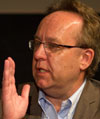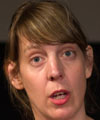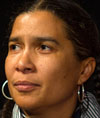| Documentary Film and New Technologies | |||||
| Tuesday, March 20, 2012 Gerry Flahive is a producer for the National Film Board of Canada. He has produced more than 50 films and new media projects including Project Grizzly, Waterlife and Highrise. Shari Frilot is senior programmer for the Sundance Film Festival and curator of the New Frontier section of the event. Ingrid Kopp is the new media consultant at the Tribeca Film Institute where she runs the TFI New Media Fund. Launched in 2011 with the support of the Ford Foundation, the funds seeks to develop interactive, non-fiction projects centered around issues of social justice. Patricia R. Zimmermann is professor in the Department of Cinema, Photography and Media Arts at Ithaca College and codirector of the Finger Lakes Environmental Film Festival. She is the author of Reel Families: A Social History of Amateur Film and States of Emergency: Documentaries, Wars, Democracies and coeditor of Mining the Home Movie: Excavation in History and Memories. Moderator: William Uricchio is professor and director of MIT Comparative Media Studies and professor of comparative media history at Utrecht University in the Netherlands. His books include Media Cultures (2006), on responses to media in post 9/11 Germany and the US, and We Europeans? Media, New Collectivities and Europe (2009). [This is an edited summary, not a verbatim transcript.] By Katie Edgerton, CMS Photos by Greg Peverill-Conti
“What’s going on right now in documentary is nothing short of transformational.” With those words, moderator William Uricchio, Director of MIT’s Comparative Media Studies program, kicked off March 20’s Communications Forum on Documentary Film and New Technology. “We’re at a turning point in film,” Uricchio said. Interactive cinema, long thought a pipe dream, is close to becoming a reality. New technologies are changing the ways people create and consume media. Often overshadowed by fiction film, “documentary is pushing the envelope.” The past decade has seen a proliferation of web-based documentary forms. There are non-linear films, where audiences piece a story together from asynchronous clips; collaborative documentaries, created from media submitted by web visitors; database documentaries, which make archives navigable; transmedia documentaries, where narratives are spread across multiple platforms; and location-based documentaries, which integrate media into the lived environment using mobile technology. While some may see this as a unique moment, “historically, documentary has been a driver of technological innovation,” said Uricchio. Documentarians were among the first filmmakers to experiment with cinema technologies of the past—sound recording, color film, 16mm film stock, and portable cameras. In fact, nonfiction storytellers quickly embraced cinema itself. Eighty-percent of the movies copyrighted in the first decade of film (1895-1905) were nonfiction. “This is an incredibly exciting moment,” Uricchio said. “We’re seeing new forms that have not yet been tamed. There’s not yet orthodoxy for people to fall back on. There’s nothing but possibility.” But potential also brings uncertainty, and with it, a host of challenges. Uricchio outlined four key areas for inquiry: funding, collaboration, evaluation, and preservation. Funding is a struggle for independent filmmakers in general, and documentarians in particular. While a few institutions like the National Film Board of Canada (NFB) support new media documentaries, nonfiction filmmakers often have to piece together funding from a variety of sources. Furthermore, since web-based documentaries often defy traditional conceptions of film, mediamakers looking for funding face a dilemma: should they reach out to documentary funds, or organizations that support new media? Often, web documentary projects fall outside foundations’ narrowly defined scopes, rendering them ineligible for funding. What are different models for supporting web documentaries, Uricchio asked, and how might we as a society build institutions that support this new work? Collaboration is also a key issue. New documentary forms draw together individuals with different expertise: filmmakers, technologists, artists, cartographers, academics, designers, game developers, activists, and community members. How can such a diverse group build a common language, let alone collaborate? Furthermore, web-based documentaries often invite audience members to contribute their ideas, media, or time to a project. “What are the legal and ethical implications of building on the work of ‘the crowd’?” Uricchio asked. Evaluation is not just about telling good documentaries from bad ones, Uricchio said. It’s important to funders, who need metrics for accountability. It’s also helpful for audiences. “If people watch a few bad [web documentaries], they likely won’t go back for more,” Uricchio said. “How can we build up a body of criticism to understand these new film forms?” Preservation is a critical issue in today’s Internet, and web-based documentaries are no exception. “How do we preserve these artifacts?” Uricchio asked. “Many are on relatively fragile platforms: here today and gone next year.”
“We’re at a moment of utopianism,” said Patricia Zimmerman, Professor of Cinema, Photography and Media Arts at Ithaca College. “People have a tendency to say that every problem will be resolved by new technologies and tools.” Cautioning that technologies “are not static,” Zimmerman argued that the excitement and anxiety surrounding new documentary forms has precedent. “Never has there been a new technology met without equal parts hope and despair,” she said. Funding “I do what every other film producer does,” said Gerry Flahive of the National Film Board of Canada, “except, I’m a civil servant.” Founded in 1939 by British documentarian John Grierson to “interpret Canada to Canadians,” the NFB has made more than 14,000 films, establishing itself as a worldwide leader in documentary. “We’re a government department, but we don’t make government films,” Flahive said. “We’re very director-driven. The focus is on point-of-view documentaries.”
Flahive helped launch the NFB’s first interactive filmmaking unit in 2004, prior to the release of the Internet video site YouTube. “For us,” Flahive said, “the move into interactive was about embracing creative possibilities.” Since 2010, Flahive has been producing the web-based documentary HIGHRISE in collaboration with director Katerina Cizek. The Emmy-award winning film explores vertical living in many of the world’s major cities, using collaborative, non-linear storytelling techniques. While interactive work opens up exciting creative possibilities, it also costs less than traditional documentaries. Flahive estimated that Out My Window, the NFB’s Emmy-award winning web-based project with Cizek, cost $150,000. “If we’d done that as a film, it would have cost $750,000,” he said. Furthermore, web-based forms enable organizations like the NFB to reach viewers all over the world. Traditional documentaries are often distributed theatrically or broadcast on television within specific national markets, drastically limiting the audience. Currently, 25% percent of the NFB’s budget is devoted to interactive work. However, the NFB is “a uniquely Canadian institution,” Flahive said. He acknowledged that it would be hard to replicate this model in other national contexts, particularly the United States.
Ingrid Kopp, a consultant for Tribeca Film Institute’s (TFI) New Media Fund, characterized American documentarians as “story entrepreneurs.” Since the United States lacks a governmental funding body like the NFB, documentary filmmakers have to piece together funding from groups like Kopp’s wing of the TFI, which provides start-up grants of $50,000 to $100,000 to 4-8 interactive projects each year. Getting a documentary off the ground is so difficult in the United States, Kopp said, there’s not much room for experimentation, failure and—most importantly—learning. In an ideal world, web documentary production should follow the corporate model of research and development. “We need more rapid prototyping and experimentation,” Kopp said, noting that best practices often emerge through trial and error. Shari Frilot, curator of the Sundance Film Festival’s annual New Frontier exhibition, said she saw a growth of interest in new media storytelling following the 2008 financial crisis. “The bottom dropped out of the independent film world in 2009,” Frilot said. In response to mounting costs and dwindling audiences, major film studios shut the boutique units that had supported and distributed independent movies. Forced to look elsewhere for innovative work, many filmmakers, distributors, and audiences came to festival exhibitions like New Frontier. “We’re about expanding cinema culture,” Frilot said. New Frontier highlights works, often drawn from the art world, that push the boundaries of video narrative. “We’re building a space within [film] festival culture for new kinds of storytelling,” she said. “Audiences and industries are catching up with artists.” Noting a rise of “social entrepreneurship” among health care non-profits, an audience member asked if there were any similar trends in the new media and documentary space. Kopp cited the TFI-funded 18 Days in Egypt as an example. Team leaders Jigar Mehta and Yasmin Elayat were not only creating 18 Days, an interactive documentary about Egypt’s Arab Spring, they planned to bring GroupStream, the web-based platform upon which the documentary ran, to market. Collaboration “We’re moving from the one to the many,” said Zimmerman. “Today, even feature films have many iterations. Before, we had fixity, not we have fluidity… long form storytelling is now part of a beautiful ecosystem of many multiplying forms.” Many of these forms hinge on collaborations between filmmakers and technologists, storytellers and designers, audience members and authors. Web work often poses a technical challenge to traditional documentarians, said Flahive. Filmmakers have to work with programmers and designers—who may have different technical sensibilities and priorities. TFI encourages collaboration between the technologists and filmmakers who receive its grants. Kopp’s fund builds in mentorship labs, facilitating connections between filmmakers, coders, and designers. TFI also hosts a monthly “meet-ups,” where media makers can discuss the issues facing each of their projects and brainstorm solutions.
Crowdsourcing—collecting media and ideas from audience members to use in a project—has recently received a lot of press in the documentary world. “I don’t think crowdsourcing works unless there is a strong creative concept behind it,” said Flahive. He cited HIGHRISE as a good example of collaborative documentary. The HIGHRISE production team, led by Flahive and director Katerina Cizek, cooperates with academics and local community members. However, “we’re talking about degrees of collaboration,” said Flahive, noting that most projects, HIGHRISE included, benefit from a strong authorial sensibility. Kopp acknowledged the potentials of crowdsourcing, but added that web users rarely send content to filmmakers, even when they’re asked directly. The project team of the TFI-funded 18 Days in Egypt planned to tell the story of the 2011 Egyptian Revolution using crowd-sourced video, images, and other media, but ran into a serious problem. Very few Egyptians submitted content to the documentary. The 18 Days team eventually had to fund Egyptian-based researchers to collect media. Digital access is also a key issue, said Zimmerman. “People are excited about user-generated content.” Worldwide, however, user-generated content is sometimes knows as “American-generated” content. People in first world countries have time and technology; they can participate in crowd-sourced projects. “Technologies, networks, and nodes are not the same around the globe,” Zimmerman said. “Has the role of the filmmaker evolved to equip audiences with tools to create the story?” asked a member of the audience. Zimmerman said that she saw a shift from the idea of a filmmaker as an “individual director” to an “experience designer” or “convener.” Many of today’s filmmakers, she said, think of narrative structures as ways to create community. Evaluation “We know all the bases a traditional documentary has to hit to be a ‘success,’” Kopp said. “What are the evaluation benchmarks for web documentaries?” Kopp said she found it difficult to balance evaluation with collaboration. Since new documentary forms were in flux, Kopp did not want to be prescriptive, unintentionally limiting creativity. While acknowledging the importance of evaluation, she noted that there should also “be a space for experimentation and good failures.” Distributing work online also opens up new possibilities for numerical evaluation. “With interactive work, there’s a stream of data,” Flahive said. His team was able to pinpoint who visited the NFB’s web-based work, and how long they stayed. “We found that 7 minutes is about as long as people will stick around,” Flahive said. “But there’s a high return rate.” Waterlife, the NFB’s most visited web documentary, has been seen by 1.5 million people, based all over the world. Flahive pointed out that this kind of reach would have never been possible in a traditional broadcast distribution model. Preservation “How do you deal with unstable platforms?” asked David Thorburn, Communications Forum Director. “What does an aspiring documentarian do when facing the enormous number of choices of technological platform, and the question of whether or not her platform will be around in five years?”
“The answer is very simple,” said Frilot. “You start with story.” If an aspiring filmmaker has a story she wants to tell, each platform provides her with a different avenue. While the platforms may not be monetized in the traditional film distribution model, they might actually extend a film’s reach, and put a mediamaker in conversation with new audiences. Flahive also emphasized story. “Find the right medium for the idea,” he said. Interactive documentaries are “in conversation” with linear films. Different platforms had different strengths and weaknesses. “What might seem trivial on film,” Flahive said, can be arresting on the web. Streaming audio of "Documentary Film and New Technologies" is available. A downloadable podcast of "Documentary Film and New Technologies" is available. Video of "Documentary and New Technologies" is available.
| |||||






